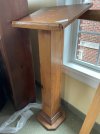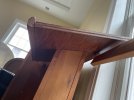Hey all - my church asked me to take this old lectern they found in a building they are moving into and put on a new top and refinish. As I dove into the project, the post is pine - really nice fine grain pine at that. It was assembled with nails with butt joints. The top and bottom were also assembled with nails. They actually gave me a top they found to put on. It's red or white oak. They wanted to use as many pieces from the original building as possible. The only other pieces that will be new are the base which needed a total replacement, since it had checked badly. All that to say, how would you all attack the joinery of the top to the post? Complicated or simple solutions welcome!
Here are a couple
 pics in its original state.
pics in its original state.


Here are a couple


